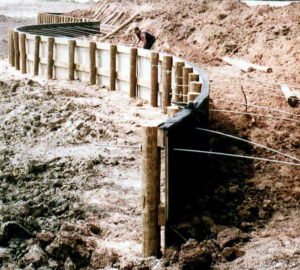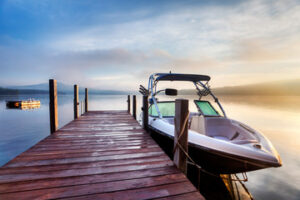Bulkheads Construction and seawalls are tall, vertical structures found in marine construction projects. Like all structures, they serve a vital purpose to the communities and ecosystems that surround them.
They prevent erosion on waterfront properties and preserve the surrounding ecosystems. They can be made from a variety of materials, including vinyl, concrete and steel.

Bulkheads increase the strength and rigidity of a structure, helping it to withstand a variety of environmental stresses. Their structural integrity is especially critical on ships, where they provide a crucial safety function by dividing watertight compartments in case of hull breach or flooding. In addition to providing stability, bulkheads also limit the spread of fire and smoke, improving safety for passengers and crew.
A bulkhead can be constructed from a variety of materials, including treated wood, vinyl or concrete. Choosing the right material is essential for creating a durable, attractive structure that complements the design of your property. If you are considering adding a bulkhead to your home, it is important to work with a reputable contractor who can provide references and has a good track record with the Better Business Bureau. It is also important to ask the contractor for a detailed up-front cost estimate, so you can compare the price with other options.
Construction of a bulkhead typically begins with site preparation. The contractor may clear the area and prepare a foundation, depending on the design specifications and soil conditions. Once the foundation is in place, the framework of the bulkhead is constructed. Panels or walls are then installed within the framework, and any finishing touches, such as surface treatments or insulation, are applied.
Many bulkheads are designed to be permanently fixed, but others can be moved. These types of structures are typically placed along the transition between land (filled or natural) and sea in port basins and reclaimed areas. They can also be used along natural or bluff shorelines, where a well-defined separation is required to resist earth pressures.
In addition to protecting against erosion, bulkheads can also be used to protect beachfront developments. They can be designed to prevent toe scour and sliding on subsurface critical failure planes, as well as stabilize slope instabilities and prevent coastal drift.
In addition to enhancing the appearance of a building, a bulkhead can be constructed to reduce noise and thermal variations between different rooms. For example, a kitchen-living room bulkhead can separate the spaces without the need for doors, allowing homeowners to enjoy the benefits of both rooms while maintaining an open, flowing space.
Materials
A bulkhead is a wall that divides space and provides structural support in structures like buildings or ships. It can be made from a variety of materials, depending on the design and environmental conditions. They are generally constructed from materials that are durable and less prone to water absorption, such as vinyl or concrete.
The purpose of bulkheads is to protect property from erosion, mainly on land that borders bodies of water. They can also be used to reinforce the load-bearing capacity of a building by evenly distributing the loads. In addition, bulkheads can provide sound and fire resistance.
Marine bulkheads are often made from concrete or fiberglass, but they can also be made from steel, wood, or composite materials. They are typically built with a pylon or piles (also called walers) that support the bulkhead and provide stability. The walers are usually made of treated timbers, and the bulkhead is connected to these walers with galvanized tie-rods.
For coastal properties, bulkheads can be a cost-effective solution for protecting the shoreline. They are typically built with a retaining wall system that consists of concrete, vinyl sheet pilings, or timber walers. These structures are designed to withstand the forces of wind, waves, and tides.
The first step in constructing a bulkhead is site preparation. The construction site is cleared and prepared, with the foundations laid according to the bulkhead design. A framework is then constructed to support the walls and other components of the bulkhead. The walls are then installed, and the structure is inspected and repaired as necessary.
A common misconception is that bulkheads are only designed for coastal properties. In reality, they can be used to protect all types of properties from erosion, including residential homes and commercial businesses. The best way to determine if a bulkhead is right for your property is to talk with a marine contractor and request a quote.
Marine contractors are experienced in designing and installing bulkheads that can withstand the test of time. They can also recommend the most suitable material for your specific project. For example, they can help you select the best type of pilings for your bulkhead. While wood pilings are relatively inexpensive upfront, they don’t hold up to the elements as well as composite pilings, and they leach toxic chemicals into the water.
Installation
Bulkheads can serve a number of roles within a house, including separating rooms and increasing the structural integrity of the home. They are often constructed with non-combustible materials and meet insulation requirements as specified in building standards. In addition, bulkheads provide fire protection for the first 60 minutes following a fire.
Waterfront homes and businesses are especially vulnerable to damage caused by waves or currents, but proper bulkhead construction can prevent costly repairs and add value to property. A professional marine contractor like Brumfield Construction can help homeowners and business owners choose the best material and design to protect their investment.
In addition to their protective qualities, bulkheads can also add a unique look to a waterfront home. They come in a variety of styles, from wooden to vinyl and concrete, so you can find the perfect finish to match your home’s decor. In addition, a well-constructed bulkhead can be used as an aesthetic accent for your landscaping and yard.
One of the most common roles of bulkheads is to retain fills along the water edge of reclaimed areas and in port basins. They also serve as a separation between land, natural or filled, and the sea in protected environments.
Erosion can be a silent enemy, slowly eating away at the dry land surrounding your property. Bulkheads can help retain soil and prevent erosion from washing away your property’s valuable assets.
The first step in constructing a bulkhead is to clean the area around the hole where it will be installed. Make sure that the hole is a suitable size to accept a PVC bulkhead.
When installing a new bulkhead, it is important to clean and dry the flange and gasket mating surfaces before screwing in place. This will ensure a tight seal. It is also a good idea to remove any silicone or thread lubricant from the flange and nut before reinstalling. These lubricants can cause the bulkhead to scoot out and not seal properly.
Once the bulkhead is in place, it is necessary to add a waterproof seal to its top surface. This will prevent water from seeping through the bulkhead into the wall cavity and causing serious damage. A waterproof sealant can be purchased at most hardware stores.
Repair
Bulkheads protect waterfront properties from the forces of nature, including waves, tides, and storm surges. Like any structure, bulkheads can deteriorate over time due to age and environmental factors, but professional repair methods can extend the lifespan of these critical waterfront structures. Coastal property owners should take regular steps to keep bulkheads in good condition. A professional inspection can help identify the cause of damage and determine the appropriate solution.
When repairs are needed, it is important to hire a company with experience in marine construction. Waterfront lots can be challenging to work on because of the presence of houses, trees, landscaping, docks, davits, outdoor living spaces, underground utilities and other site improvements. These obstacles can increase project costs and impact the safety of all involved. A professional marine contractor will have the expertise and equipment to minimize these challenges and complete a successful repair on time and within budget.
Often, bulkheads suffer from damage that results in soil erosion. This can be caused by a variety of factors, including waterline failure, rust marks and vertical cracks. These problems can be corrected by injecting polyurethane foam, which fills voids and reinforces the bulkhead to prevent further damage.
A rusted or corroded tieback rod is another common cause of bulkhead damage. These rods are used to hold the walers in place and are usually made of steel or galvanized metal. If the rust or corrosion is allowed to continue, the integrity of the walers and the bulkhead may be compromised. A professional repair service will perform a thorough inspection and drilling to accurately assess the damage and make an informed decision about the best repair approach.
The final step in repairing a damaged bulkhead is to waterproof it. This is accomplished by sealing any open cracks or voids in the sea wall and applying a protective coating that will withstand the elements. A waterproofing treatment will also extend the life of the structure and improve its ability to withstand future environmental factors.
Performing a bulkhead repair is crucial to maintaining the integrity of your waterfront home or business. A faulty bulkhead can result in expensive damage to your property and create safety hazards for you and your family. In addition, a faulty bulkhead can damage the environment and cause flooding. By following the six tips outlined in this article, you can ensure that your bulkhead is safe and in good condition for years to come.
